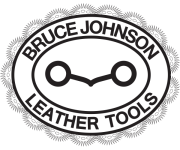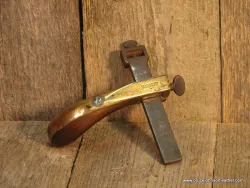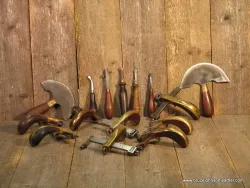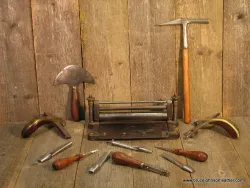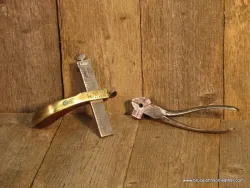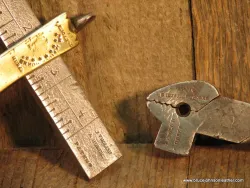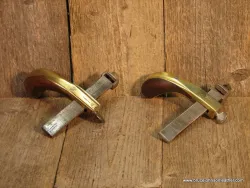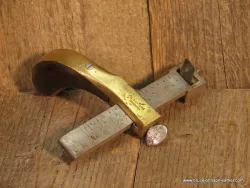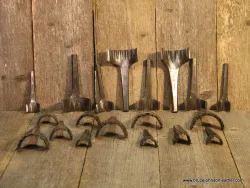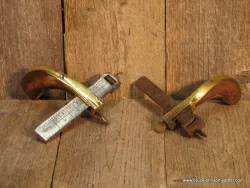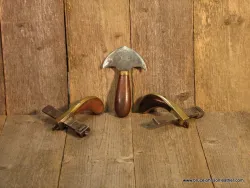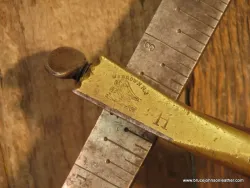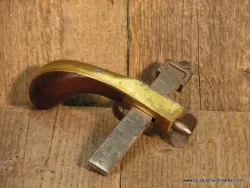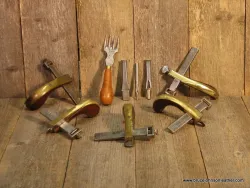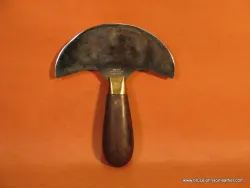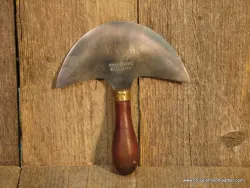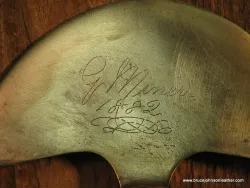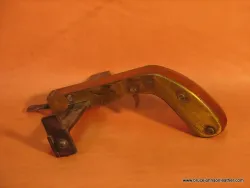My Tool Collection
I had an old friend who taught me a lot about tools. He had been in the trade his whole life and knew handtools and uses. Some of my best times were sitting with him and he'd say "Did I ever show you how to do this?" or "Did you ever try one of these edgers?". He'd pull out a tool and show me some little tip, and usually I'd buy the tool. Education is priceless but not free. I got to where I knew the common Gomph, CS Osborne, HF Osborne, and PB McMillen tools pretty well.
I never really set out to start a tool collection. That sort of changed with finding a Francis & Ward draw gauge in a local antique store several years ago. I brought it home, put a blade in it, and it just fit my hand well. I used it for maybe a month and got interested – who were these guys? I did a little internet research and found that it was made between 1856-1859. One hundred and fifty years old from Newark NJ and I was dragging it though reins and belts in Oakdale, CA. A short while later I found an old draw gauge with a short trigger and marked "HOS". A really nice draw gauge too that bled history. That introduced me to Henry Sauerbier tools and the horse left the corral so to speak. I had developed an interest in not only the 100 year old tools, now the door opened for their predecessors. If anyone has any further information or corrections on these makers I would sure appreciate it.
Several years ago I curated an exhibit of saddle making tools for our local cowboy museum. I got a lot of emails and calls from people who had visited and surprised at the age of the tools and designs that really haven't changed much in 150 years. With that in mind, I have decided to share some of the other tools in my collection. I know several who collect tools. A lot times their collection is squirreled away and only they and people who visit them ever get to see it. Like a lot of collections, my tools are probably not for sale except for a scant few duplicates. Every once in a while I still put a blade in a Huber, or a Crawford, or an English and pull a few straps. Pretty cool feeling to wonder who used it 150 plus years ago and what was he making.
Francis & Ward Draw Gauge
Francis and Ward – Newark NJ from 1856 through approximately 1859. This draw gauge started it all for me.
Sauerbier Tools
Henry Sauerbier - Newark NJ and started in 1848. The early marks are reported to be the “HOS”, later marks are H Sauerbier, H Sauerbier Newark NJ, H Souerbier (spelling error? – yes, to those in the know I have a bar marked like that), and in 1870 changed to H Sauerbier & Sons followed by H Sauerbier Sons. Sauerbier also made swords during the Civil War and I get inquiries from sword collectors who find my mention of his leather tools. Represented here are draw gauges, round knives, stitch channeler, pricking wheel, decorative wheel, and two double line creasers.
William Dodd
Newark NJ. Wm Dodd was the brother-in-law of CS Osborne. Dodd and Osborne were grocers and parted ways. Dodd had a background of tools and purchased the tool business of Joseph English. There is some variance of when CS Osborne bought Dodd’s business with dates reported from 1858 up to 1862. I like the Dodd tools quite a lot. A really rare Dodd Marked splitter, two draw gauges, round knife, saddler hammer, channeler, two patent leather stitch groovers, and some punches.
English & Huber Sheffield
English and Huber – listed together at the Sheffield Works in Philadelphia in 1834. There is some question as to how long they were there. They were listed as making tomahawks, beaver traps, and their Bowie knives were prized then and now. I have a draw gauge and a saddlers pliers/pincers. Another closeup view shows their marking.
Joseph English
In business from 1826 through 1856 at different locations. He sold the business to Wm Dodd in 1856. Dodd later sold to CS Osborne. CS Osborne lists the CS Osborne company as established in 1826. That would be when J English was first a tool maker, not when CS Osborne as a company came into being. I have two J English draw gauges.
Daniel English – brother of Joseph English. He was listed as a cutler in 1842 and died in 1849.
H Huber
H Huber – Philadelphia. I can find scarce little information on much of the timeline for Henry Huber. He was reported to be one of the premier makers of Bowie knives and the knife collectors give big money for one. He was on his own for some period of time but was listed with Joseph English at the Sheffield Works in Philadelphia from 1834 on for a few years. Here are two draw gauges and a set of punches that are super cool
William Brown
Newark NJ. One of the seemingly rarer ones to come across as well. Listed from 1844-1854. He made a pretty mark on his draw gauges. Two draw gauges and round knife.
John Charlton
Newark NJ. I can’t find a lot of concrete information on John Charlton other than he was listed from 1850-1889. Draw Gauge
Aaron Crawford
Newark, NJ. A Crawford is listed as being from 1838-1875. I have just plain Crawford marked tools and and others marked as Crawford and Sauerbier. He also had alliances or partnerships with other tool makers at different times. Here are 5 draw gauges, a straining fork and a few punches.
Pratt & Letchworth
Buffalo, NY. Seemed to be a large company with a varied line. Two Pratt brothers formed a partnership with Letchworth in 1845 and the firm last several decades. They made several cast items and eventually were recognized for the toys they made in the late 1800s. One interesting thing I found on them was they had pretty grounds and were building nice accomodations for workers. Another account I read was that Letchworth came from another firm that used inmate labor, and it was reported he contracted inmate labor for the new firm as well. Makes me wonder about the worker accommodations. I have a pretty nice round knife.
Dixon
An English tool company started in 1843 and long continuous family ownership. OK, so Dixon knives aren’t particularly rare and the older ones are excellent using knives. Rundi saw this one and immediately laid claim to it. The owner had inscribed “G Miner” and “1882” on the backside along with a decorative flourish. I cut a rope can cover with it to christen it into the shop, and it now resides in Rundi’s front room cabinet with a lace cutter, reata, Hummel and dancing lady figurines, spurs, and her other collectibles. Well played, Mr Miner.
GSP
I don’t know who GSP is, but he was proud and marked this in three places. It looks to be a shop or home made version of a draw gauge. Probably dates to the 1800s. It is big, squarish, and a bit clumsy. It may have been an apprentice made tool even. The blade is screwed onto the end of the scaled beam. Still something about grabbed me and I hung it up. I sharpened the blade up a couple years and cut some 3” leathers with it. GSP, where ever you were from and whoever you were, your draw gauge works and at least one guy still thinks about you.
